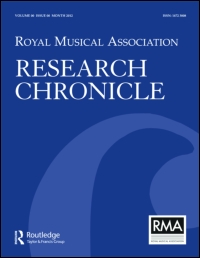No CrossRef data available.
Article contents
Dedications in Morley's Printed Music
Published online by Cambridge University Press: 01 January 2020
Extract
Morley started to publish his secular music in 1593, and maintained an average of more than a volume per year seen through the press until his death in 1602. This article attempts to discover whether there were any discernible motives for dedicating works to particular patrons thereby invoking their support. Such motives may well not be apparent today removed as we are from the everyday pressures and needs of an Elizabethan musician, and Morley may even have wished to conceal his reasons for adopting certain particular patrons for his publications - possibly to avoid allegations of nepotism or unfair dealings - even if he wanted the outward display of their public support. But searching for motives behind some of the dedications is not totally futile even if it is, for lack of concrete evidence, necessarily mostly speculative.
- Type
- Research Article
- Information
- Copyright
- Copyright © Royal Musical Association, 1976
References
1 Doubt has been expressed as to whether Morley died in 1602. But since on 7 October 1602 George Woodson was sworn in as a Gentleman of the Chapel in “Thomas Morley's room” and Chapel appointments were made for life, Morley was almost certainly dead by October. See also T. Dart's ‘Introduction’ to A Plaine and Easie Introduction to Practicall Musicke, ed. A. R. Harman, London 1952, revised 1966, p. xviii.Google Scholar
2 L. Ruff: ‘The social significance of the 17th-century English Music Treatises', The Consort Vol 26, 1970, p. 412.Google Scholar
1 J. Aubrey: Natural History of Wiltshire, London 1847, p. 86.Google Scholar
2 E. F. Rimbault: The Old Cheque Book of the Chapel Royal, Camden Society, New Series No. III, London 1872, pp. 5 and 34.Google Scholar
3 D. Brown: ‘Thomas Morley and the Catholics: some speculations', Monthly Musical Record, 1959, p. 53.Google Scholar
4 W. Shaw: ‘Thomas Morley of Norwich', Musical Times September 1965, p. 669.CrossRefGoogle Scholar
5 T. Dart: ‘A suppressed Dedication for Morley's four-part Madrigals of 1594', Transactions of Cambridge Bibliographic Society, III, 1963, p. 401.Google Scholar
1 L. Ruff: ‘The Madrigal, the Lute-Song, and Elizabethan Politics', Past and Present 44, 1969, pp. 3 – 51.CrossRefGoogle Scholar
2 Details of other dedications to Puckering may be found in F. B. Williams: Dedications and Commendatory Verses in English Books before 1641, Bibliographical Society III, London, 1962.Google Scholar
1 Calendar of Mss. of the Marquess of Salisbury at Hatfield, Historical Manuscripts Commission, Salisbury VIII, London 1899, p. 273.Google Scholar
1 Cf: Richard Marlow: ‘Ferdinando Heyborne, alias Richardson', Musical Times, September 1974, pp. 736–9.CrossRefGoogle Scholar
2 Further information in D. Poulton, John Dowland, London 1972, p. 394.Google Scholar
1 D. Scott: Music of St. Paul's Cathedral, London 1972, p. 13.Google Scholar
2 Nicolas Yonge: Musica Transalpina, London, 1588.Google Scholar
3 Calendar of State Papers, Dom. Ser., 1598–1601, p. 94 (Doquets in S. P. 38), and printed in Richard Allison's The Psalms of David in Meter, London 1599, fol. A3vGoogle Scholar
4 Vicary Gibbs (ed.), Complete Peerage, London 1913, Vol. III, p. 308.Google Scholar
1 See also D. Poulton, op. cit., p. 400.Google Scholar
2 W. A. Shaw: Knights of England, London 1906 II, p. 95.Google Scholar
3 The Unton painting is in the National Portrait Gallery, London.Google Scholar
4 See W. Woodfill: Musicians in English Society from Elizabeth I to Charles I, Princeton, 1953, pp. 33–53 and Appendix A. See also J. C. Bridge: ‘Town Waits and their tunes', P. M. A. 1928, Vol. 54, pp. 63–92.Google Scholar
5 There is a further five-part Pavan and Galliard of Morley's “sett by Peter Phillips” in Tregian's anthology, British Library, Egerton 3665, f. 518'.Google Scholar
6 W. A. Shaw: op. cit., II, p. 115.Google Scholar
7 F. B. Williams: op. cit., p. 21.Google Scholar
1 E. Hasted: A History of Kent, Canterbury 1778–82, Vol. I, pp.309, 349, 356.Google Scholar
2 J. A. Venn: op. cit., Vol. I, p. 184.Google Scholar
3 L. Ruff: art. cit., Past and Present 44, p. 22.Google Scholar
4 J. Chamberlain: Letters, ed. N. McClure, American Philosophical Soc., Philadelphia 1939, p. 169.Google Scholar
1 E. H. Fellowes: English Madrigal School, Vol. 32, revised edition and preface by T. Dart, 1963, London, 1963.Google Scholar
2 J. Chamberlain: Letters in Elizabeth's reign, ed. Sarah Williams, Camden Society, London, 1861, p. 133.Google Scholar
3 Liber Niger Dominus Regis Edward. IV, Ordinances of the Royal Household, Edw. III to Wm. and Mary., Society of Antiquaries, London, 1887, p. 50.Google Scholar
4 E. F. Rimbault: op. cit., p. 34.Google Scholar




